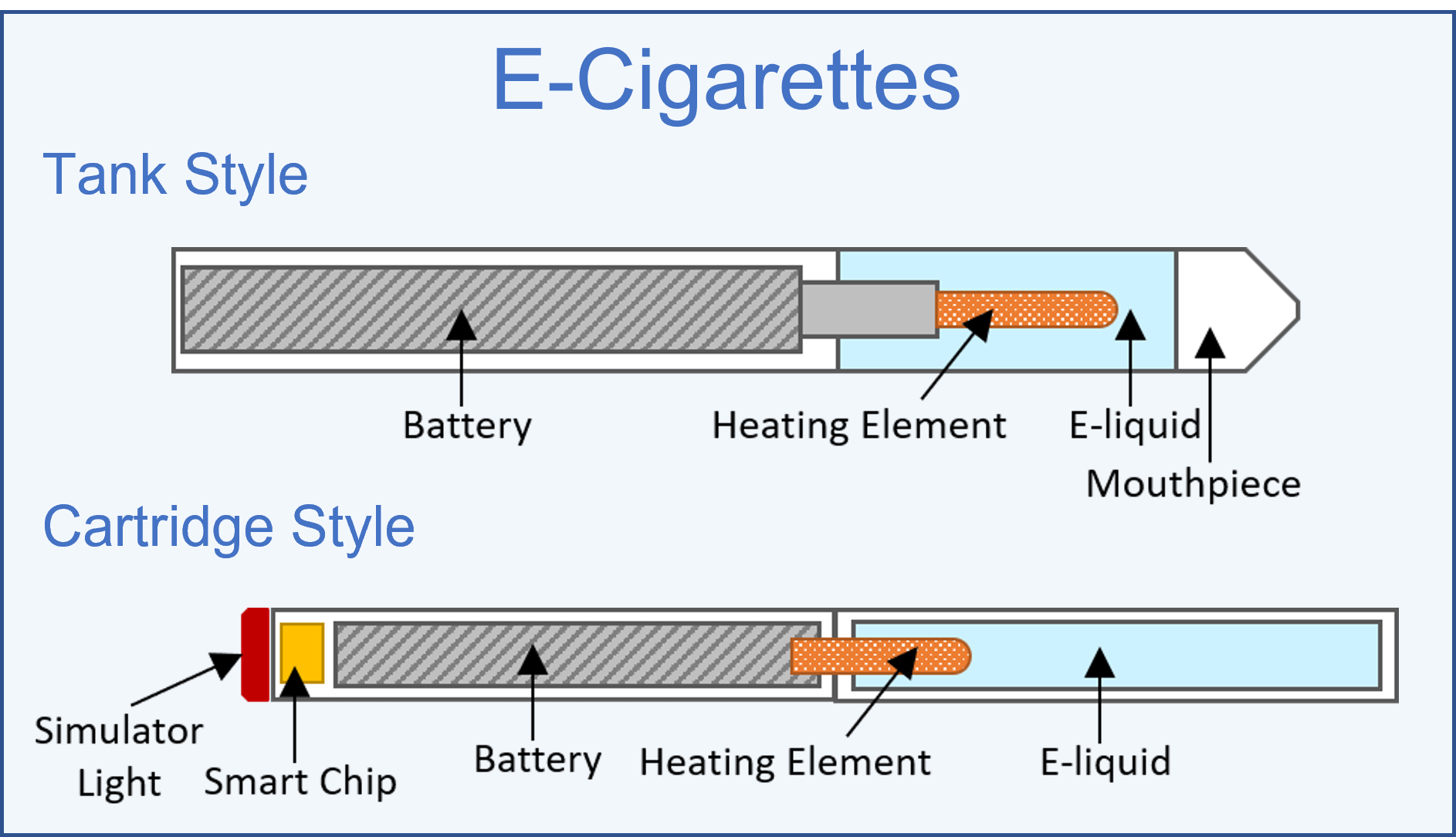E-cigarettes: The Basics
This page was last edited on at
This page gives a basic summary of what e-cigarettes are, how they work and what they contain. It does not attempt to describe or assess their safety.
What Are E-cigarettes?
E-cigarettes, also known as electronic cigarettes or electronic nicotine delivery systems (ENDS), work by heating a nicotine containing liquid, producing emissions usually described as a ‘vapour’. They consist of a battery, a cartridge (disposable, replaceable or refillable) with liquids (called ‘e-liquids’) and a heating mechanism. This heats the cartridge ingredients to create a ‘vapour’ that is inhaled by the consumer. They do not contain tobacco and there is no combustion or smoke, but some emit ‘clouds’ resembling vapour. Odour is produced by flavours which are added to the liquid. E-cigarettes are used like conventional cigarettes: when the user draws on an e-cigarette, a visible cloud of aerosol is produced, mimicking the smoke of a conventional cigarette. With some ‘cig-a-likes’ (see below) a simulator LED light mimics the glow of a conventional cigarette.
What Different Types Are There?

Figure 1: Common types of e-cigarettes.1
Many e-cigarettes are manufactured to look like conventional cigarettes, cigars, or pipes.while others resemble everyday items such as pens and USB memory sticks. Some models are single use, often called ‘disposable’. Some are designed to be refilled with cartridges (or ‘pods’) and some are also rechargeable, for instance via USB.
Vapourisers and ‘tank systems’ tend to be bigger, including ‘mods’ (from ‘modification’) which allow the user to assemble or customise their device, for example by changing size or battery power.
Detailed descriptions of different types of e-cigarette can be found on Wikipedia: Electronic cigarette
What Are ‘Vapes’?
Tobacco industry product terminology changes with developments in products, shifts in business strategy and new marketing tactics. As for other newer nicotine and tobacco products, the terms used to refer to e-cigarettes have changed over time.
Tobacco companies now generally refer to all their e-cigarettes as ‘vapes’, short for ‘vapouriser’ (‘vaporizer’ in the US), which has the effect of distancing them from conventional cigarettes.2 On their company websites in 2022, British American Tobacco (BAT) and Imperial Brands referred to their e-cigarettes as ‘vapour products’;34 Philip Morris International (PMI) used the term ‘e-vapor’;5 and only Japan Tobacco International (JTI) referred to their current products as ‘e-cigarettes’.6
- See the page on Product Terminology for more information.
What Is In E-liquids?
The liquids used in most e-cigarettes are usually sold in a bottle or in pre-filled disposable cartridges and may include nicotine as well as variable combinations and quantities of water, glycerol, propylene glycol, flavourings and other ingredients. A huge number of flavours are available, from tobacco and menthol flavours to those resembling sweets, like bubble gum, or cherry or strawberry. The latter are prohibited for use in regular cigarettes because of concerns that such flavours appeal to children.
In late 2019, US President Donald Trump announced an intention to ban e-cigarette flavours in the US, with the possible exemption of some flavours such as tobacco and menthol.789 After lobbying from the e-cigarette industry, it appeared that the ban would be watered down to exclude menthol and tobacco flavours, and would continue to allow fruit and sweet flavoured e-liquids to be sold for re-fillable ‘tank’ devices.10111213
How Much Nicotine?
E-liquids are sold in different nicotine concentrations. In some countries the level of nicotine in e-cigarettes is restricted. In the European Union the maximum concentration allowed is 20mg/ml (20%). In the US, as of 2020, there is no maximum level set by law, and some e-cigarettes (including JUUL Labs’ JUUL) contain much higher levels, up to three times that amount.14 In other countries, including Australia, it is illegal to sell products containing nicotine without a licence, and therefore e-liquids containing nicotine are not openly available without a prescription.
It is also possible to buy flavoured liquids for e-cigarettes without nicotine (labelled 0% nicotine). Some tobacco companies sell these liquids, although the majority of their products contain nicotine.
Nicotine can be extracted from tobacco leaf in different ways for use in e-liquids. The most common ‘freebase’ method enables nicotine to pass through membranes in the body more easily, but can be harsh on the throat when inhaling higher concentrations. A more recent innovation is ‘nicotine salts’, which are created when ‘freebase’ nicotine is dissolved in acid. This method can make a higher dose of nicotine more palatable and so allow higher doses of more concentrated nicotine to be consumed.15 Juul e-cigarettes use nicotine salts. All four transnational tobacco companies (BAT, PMI, JTI, Imperial Brands) also sell nicotine salt products.
TobaccoTactics Resources
- E-cigarettes
- E-cigarettes: British American Tobacco
- E-cigarettes: Imperial Brands
- E-cigarettes: Philip Morris International
- E-cigarettes: Japan Tobacco International
- E-cigarettes: Tobacco Company Interests in Single Use Products
- A list of all pages on e-cigarettes
Relevant Links
- World Health Organization (WHO): Tobacco – E-cigarettes
- Global Center for Good Governance in Tobacco Control (GGTC): ENDS
- European Commission (EC): Electronic Cigarettes
- United States (US) Food and Drug Administration (FDA): Vaporizers, E-Cigarettes, and other Electronic Nicotine Delivery Systems (ENDS)